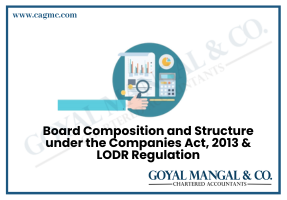
The Company Law subject is an integral part of the Chartered Accountancy (CA) Inter examination conducted by the Institute of Chartered Accountants of India (ICAI). Aspiring CAs need to have a thorough understanding of the various provisions and regulations related to companies and their operations. One important aspect of Company Law is the monetary limits and thresholds that determine the applicability of certain provisions. These limits and thresholds help in determining the scope and extent of compliance required by different types of companies. In this article, we will explore the monetary limits and Threshold Limit under Companies Act.
Meaning of Monetary Limits under Companies Act, 2013
Under the Companies Act, 2013, monetary limits refer to predetermined thresholds expressed in terms of monetary value. These limits help classify transactions or activities based on their monetary significance, making it easier to determine the regulatory framework applicable to them. Monetary limits can be found in various sections of the Act and are set to streamline compliance obligations and provide flexibility to companies based on their size and resources.
Significance of Monetary Limits
The following are the significance of Monetary Limit:
- Compliance Simplification: Monetary limits under the Companies Act, 2013 help simplify compliance requirements for companies. By categorizing companies based on their size and financial strength, the Act ensures that smaller entities are subject to lesser regulatory burden, allowing them to focus on their business operations.
- Facilitating Growth: Monetary limits play a vital role in facilitating the growth and ease of doing business. They provide flexibility to companies by granting exemptions from certain requirements or enabling simplified procedures based on their size and financial capabilities. This promotes entrepreneurship, encourages investment, and fosters economic development.
- Protecting Stakeholder Interests: While monetary limits provide regulatory relaxations, they are also designed to safeguard the interests of stakeholders. The Act imposes stricter obligations on larger companies, recognizing their greater impact on the economy and the need for enhanced transparency and accountability.
Key Monetary Limits prescribed under the Companies Act, 2013
Key Monetary Limits prescribed under the Companies Act, 2013 are as follows:
- Authorized Share Capital: The authorized share capital refers to the maximum amount of capital that a company can raise by issuing shares to its shareholders. Under the Companies Act, 2013, the concept of authorized share capital has been replaced by the concept of “minimum paid-up share capital.” It mandates that companies must have a minimum paid-up share capital based on their nature and category. The monetary limits for minimum paid-up share capital depend on the type and scale of the company, such as private companies, public companies, and companies limited by guarantee.
- Issue and Transfer of Shares: The Companies Act, 2013 imposes certain monetary limits regarding the issue and transfer of shares. These limits vary depending on the type of company and the nature of the transaction. For instance, private companies have restrictions on the maximum number of members, while public companies must comply with guidelines related to minimum subscription, minimum face value, and minimum application value of shares. The Act also sets limits on the maximum discount allowed on the issue of shares.
- Loans and Investments: To safeguard the interests of shareholders and prevent misuse of funds, the Companies Act, 2013 imposes monetary limits on loans, investments, guarantees, and securities provided by companies. These limits are based on a percentage of the company’s paid-up share capital, free reserves, and securities premium account. Any transaction beyond the prescribed monetary limits requires the approval of the company’s board of directors and, in some cases, shareholders’ approval.
- Related Party Transactions: Related party transactions refer to transactions between a company and its related parties, such as directors, key managerial personnel, and their relatives. The Companies Act, 2013 stipulates monetary limits for such transactions to ensure fairness and transparency. Any related party transaction exceeding the prescribed monetary limits must be approved by the board of directors and, in certain cases, shareholders’ approval is also required.
- Managerial Remuneration: The Act specifies limits on the maximum remuneration that can be paid to directors and key managerial personnel of companies. The remuneration is subject to various factors, including the company’s profit, financial performance, and the approval of the board of directors and shareholders. These monetary limits are intended to prevent excessive pay-outs and promote corporate governance.
Meaning of Threshold Limit under Companies Act, 2013
Threshold Limits refer to the monetary limits set by the Companies Act, 2013, to determine the applicability of specific provisions, compliances, or actions required by companies. These limits act as a threshold beyond which a company is obligated to comply with certain requirements or take necessary actions. The Act has laid down various threshold limits for different activities and transactions, such as paid-up capital, turnover, number of members, board composition, etc. These limits may vary depending on the type and size of the company.
Significance of Threshold Limits
Threshold limits under the Companies Act, 2013, serve several important purposes. Firstly, they help in distinguishing between different types and sizes of companies, allowing for tailored regulatory requirements. This ensures that smaller companies are not burdened with excessive compliance obligations meant for larger entities. Secondly, threshold limits provide clarity to companies regarding the applicability of specific provisions, making it easier for them to understand and fulfil their legal obligations. Lastly, these limits facilitate effective regulation by enabling authorities to focus their resources on companies that meet the prescribed thresholds, ensuring efficient oversight.
Key Threshold Limits under the Companies Act, 2013
Key Threshold Limits under the Companies Act, 2013 are as follows:
- Threshold Limits for Incorporation: The Companies Act, 2013, specifies different threshold limits for the incorporation of various types of companies. For example, for a private company, the minimum paid-up capital required for incorporation is Rs. 1 lakh, while there is no minimum capital requirement for a One Person Company (OPC). Similarly, the Act sets a higher threshold for the minimum paid-up capital for the incorporation of a public limited company, which is Rs. 5 lakhs. These threshold limits help in regulating the formation of companies and ensure that they have adequate resources to operate.
- Threshold Limits for Annual Turnover: The Companies Act, 2013, also prescribes threshold limits based on the annual turnover of companies. For instance, certain provisions related to financial statements, audits, and appointment of auditors are applicable only to companies that have a certain level of turnover. The Act distinguishes between small companies, which have a lower turnover threshold, and other companies. Small companies are subject to simplified compliance requirements, reducing the burden on smaller businesses.
- Threshold Limits for Board Composition: Another area where threshold limits are relevant is the composition of the board of directors. The Act mandates that certain classes of companies, such as public companies, have a minimum number of directors on their board. The threshold limit for the minimum number of directors is determined based on the type and size of the company. These requirements ensure that companies have adequate governance mechanisms in place and benefit from diverse perspectives and expertise.
- Classification of Companies: The Companies Act, 2013, classifies companies into three main categories based on their thresholds: small companies, one person companies (OPCs), and other companies. Small companies are those meeting certain criteria related to turnover, paid-up capital, and borrowings. OPCs are a special category of companies with a single shareholder as the sole member. Other companies encompass all the companies that do not fall under the small company or OPC categories.
- Applicability of Provisions: The threshold limits defined under the Companies Act, 2013, determine the applicability of various provisions, such as financial reporting, audit requirements, board composition, annual general meetings, and related party transactions. For example, small companies enjoy certain relaxations and exemptions, such as simplified financial statements, fewer mandatory board meetings, and exemption from appointing independent directors. On the other hand, larger companies have more stringent compliance requirements due to their scale of operations and impact on stakeholders.
- Impact on Compliance Burden: Threshold limits have a significant impact on the compliance burden of companies. Small companies and OPCs, being smaller in size and scale, have reduced compliance requirements, which allows them to focus more on their core business activities. This not only promotes ease of doing business but also encourages entrepreneurship and the growth of start-ups. Larger companies, with their increased resources and potential impact on the economy, have a greater responsibility to adhere to stricter compliance standards to ensure transparency, accountability, and protection of stakeholders’ interests.
- Flexibility and Scalability: The Companies Act, 2013, provides provisions for adjusting the threshold limits periodically to account for changes in the business landscape and economic conditions. This flexibility ensures that the regulatory framework remains relevant and adaptable to the evolving needs of different types of companies. As companies grow and cross the threshold limits, they need to adjust their compliance practices and align with the requirements applicable to their new category.
Introduction to CA Inter
The CA Inter, also known as the Intermediate level of the Chartered Accountancy (CA) course, is a crucial phase in the journey towards becoming a qualified Chartered Accountant. It is the second level of the CA course offered by the Institute of Chartered Accountants of India (ICAI). CA Inter builds upon the foundation laid at the CA Foundation level and equips students with a deeper understanding of various accounting, taxation, auditing, and financial management concepts.
Significance of CA Inter
The CA Inter level holds immense significance in the journey of becoming a Chartered Accountant. It acts as a stepping stone towards the final level of the CA course and provides a comprehensive understanding of diverse accounting and finance-related subjects. By completing the CA Inter level, students acquire a strong foundation in advanced accounting, taxation, auditing, and financial management, which are crucial skills for a successful career in the field of finance and accounting.
Moreover, clearing the CA Inter examination demonstrates a certain level of competence and expertise to potential employers and clients. It signifies the dedication and commitment of the students towards their professional growth and serves as a testament to their capabilities.
Structure of CA Inter
The CA Inter course is divided into two groups: Group I and Group II. Each group consists of four subjects, making a total of eight subjects. The subjects covered in Group I are Accounting, Corporate and Other Laws, Cost and Management Accounting, and Taxation. The subjects covered in Group II are Advanced Accounting, Auditing and Assurance, Enterprise Information Systems and Strategic Management, and Financial Management and Economics for Finance.
Students have the option to appear for both groups together or appear for them separately in different attempts. Clearing both groups of the CA Inter examination is a prerequisite for moving on to the final level of the CA course, known as CA Final.
Monetary Limits & Thresholds for CA Inter
Aspiring Chartered Accountants in India undergo a rigorous examination process conducted by the Institute of Chartered Accountants of India (ICAI). The intermediate level, also known as the CA Inter, serves as a stepping stone towards becoming a qualified CA. While preparing for this crucial stage, candidates must familiarize themselves with various monetary limits and thresholds that they need to understand and apply in their future profession.
Monetary Limits for CA Inter
Key Monetary Limit for CA Inter are as follows:
- Monetary Limits for Tax Audit: One of the significant aspects of a Chartered Accountant’s role involves conducting tax audits for businesses. The CA Inter syllabus covers the provisions of tax audit under the Income Tax Act. Candidates should be well-versed with the monetary limits that determine the applicability of tax audit. As of the knowledge cut-off date in September 2021, the threshold for tax audit was set at Rs. 1 crore. However, it is essential to stay updated with any revisions or amendments made by the government or the ICAI.
- Monetary Limits for GST Audit: Goods and Services Tax (GST) has revolutionized the indirect tax system in India. CA Inter students must have a sound understanding of GST provisions, including the monetary limits for GST audit. Currently, the threshold for mandatory GST audit is set at Rs. 2 crore turnovers during a financial year. Candidates should keep a close eye on any changes made by the government or the GST Council to stay up to date with the latest monetary limits.
- Monetary Limits for Companies under Companies Act, 2013: The Companies Act, 2013 imposes certain monetary thresholds on companies that determine their compliance requirements. CA Inter students need to be familiar with these thresholds to provide accurate advice and ensure statutory compliance. For example, companies with a paid-up share capital of Rs. 10 crore or more are required to appoint a whole-time company secretary. Similarly, companies with a turnover exceeding Rs. 50 crores are mandated to appoint an internal auditor. These monetary limits are crucial for CA Inter candidates to understand while dealing with corporate clients.
- Monetary Limits for Statutory Audit: Statutory audit is a crucial responsibility of a Chartered Accountant wherein they examine a company’s financial records to ensure accuracy and compliance with applicable laws. CA Inter students must be aware of the monetary limits that determine the applicability of statutory audit. As of September 2021, companies having a turnover of Rs. 1 crore or more were required to undergo a statutory audit. However, it is important to stay updated with any changes in the monetary limits prescribed by the ICAI or the Ministry of Corporate Affairs.
Threshold for CA Inter
Key Threshold for CA Inter are as follows:
- Tax Audit Threshold: The tax audit threshold refers to the monetary limit beyond which taxpayers are required to get their accounts audited by a qualified CA.
As per the Income Tax Act, 1961, the current tax audit threshold for businesses is ₹10 million in turnover (₹5 million for professionals).
CA Inter students need to be aware of this threshold while preparing financial statements and advising clients on compliance requirements.
- GST Registration Threshold: The Goods and Services Tax (GST) is a comprehensive indirect tax levied on the supply of goods and services in India. Businesses involved in the supply of goods or services exceeding the specified turnover threshold are required to register for GST. As of now, the GST registration threshold is ₹2 million in turnover for businesses operating within a single state. For businesses operating in certain special category states, the threshold is ₹1 million.
CA Inter students should understand this threshold to guide businesses in determining their GST registration obligations.
- Applicability of Companies Act, 2013: The Companies Act, 2013, regulates the functioning of companies in India and sets forth various provisions related to financial reporting, corporate governance, and compliance. Certain provisions of the Companies Act are applicable based on the size and type of the company, as defined by thresholds such as turnover, net worth, and share capital. CA Inter students need to familiarize themselves with these thresholds to ensure compliance and provide accurate advice to companies on legal and reporting requirements.
- Threshold for Statutory Audits: Statutory audits are mandatory audits conducted by qualified CAs to ensure the accuracy and reliability of financial statements. The threshold for statutory audits depends on factors such as turnover, net worth, and paid-up capital of the entity being audited. CA Inter students must be well-versed in these thresholds to determine whether a statutory audit is required and to perform the audit effectively.
- Reporting Limits for Audit Procedures: During the audit process, CAs perform various procedures to obtain sufficient and appropriate audit evidence. Reporting limits define the monetary thresholds beyond which auditors are required to report specific matters to management, those charged with governance, or other appropriate authorities. CA Inter students should understand these reporting limits to ensure compliance with auditing standards and to communicate effectively with stakeholders.
Monetary Limits and Threshold for CA Inter – Company Law
The monetary limits and thresholds for CA Inter – Company Law include the following:
- Brokerage/commission rate: In the case of shares, the brokerage/commission rate is the lower of 5% of the price at which the shares are issued or the rate stipulated by the Articles of Association (AoA).
- In the case of a public offer, the minimum application amount is 5% of the notional value or such other percentage as defined by SEBI
- Voting rights for shares with differential voting rights shall not exceed 74% of total voting power.
- The maximum amount that can be borrowed through debenture issuance is: If, and only if, a special resolution is required, Amount to be borrowed through debenture issuance + Amount previously borrowed (PUSC+ FR + SPA).
- The maximum administrative overhead for the fiscal year shall not exceed 5% of the company’s overall CSR expenditure.
- The Companies Act, 2013, prescribes the threshold restrictions such as net worth of Rs. 500 crore or more, turnover of Rs. 1000 crore or more, and other clauses that regulate threshold limits.
- The Income Tax Act, 1961 establishes different threshold limits for exemptions and other benefits, such as the basic exemption, the maximum amount of income that is not subject to income tax, and the limit on cash payments for expenses/liabilities.
- In case of preference shares Amount equivalent to the nominal number of shares to be redeemed will be transferred to the Capital Redemption Reserve.
- If the buyback is done by a Board resolution, up to 10% paid up equity capital and free reserves may be used.
If the buyback is done through a Board resolution- up to 25% paid up capital and free reserves in any fiscal year, the buy-back of equity shares may not exceed 25% of total paid-up equity capital in that fiscal year. Section 68 defines free reserves as include Securities Premium Account.
- At least 20% of deposits maturing the next year must be transferred to the Deposit Repayment Reserve on or before April 30th of each year.
- Deposits maturing in less than 6 months may be accepted by the company, but after 3 months, up to: 10% of PUSC+ FR+SPA.
- The maximum amount of deposit that can be received by: Eligible Co: 10% of PUSC+ FR+SPA from members, 25% of PUSC+ FR+SPA from the public Eligible Government Company: 35% of PUSC+FR+SPA Private Co: 100% of PUSC+ FR+SPA members Other Co: 35% of PUSC+ FR+SPA members.
- SBO: A 10% direct and indirect shareholding individual. 10% direct and indirect voting rights in shares 10% of the right to receive or share in a distributable dividend or other distribution the right to wield substantial power.
- Annual returns filed by Listed Companies and Public Companies with a PUSC of 10 crore or a turnover of 50 crore must be validated by CS in practice in MGT-8.
- A person may be designated as a proxy to act on behalf of members holding no more than 50 percent of the total share capital with voting rights.
- People who can request a poll: Co. with share capital: by members holding at least one-tenth of total voting power or shares worth Rs.5,000,000 or more paid up.
- Any other co: Members holding at least one-tenth of total voting power.
- Requisition for setting any agenda can be sent by members holding at least one-tenth of the paid-up share capital (in the event of a co. with share capital) and at least one-tenth of total voting power (in other circumstances).
- Members holding not less than 1% of total voting power or holding shares worth Rs. 5,00,000 may send a Special Notice.
- Members owning 1/10th of the paid-up share capital (in the event of a company with share capital) and 1/10th of total voting power (in other circumstances) can submit an EGM request.
- Conditions for declaring a dividend in the event of insufficient profits: Dividend rate averaged over three fiscal years – Amount to be taken 10% of PUSC + Free Reserves Balance of reserves after such withdrawal 15% of PUSC- this condition N.A. to government company whose entire capital is held by CG/SG/partially CG&SG.]
- NFRA-governed corporations/bodies:
A company whose securities are traded on a stock exchange in or outside of India. 500 crore unlisted public company – PUSC Annual revenue of 1000 crores O/S loans, debentures, and deposits totalled 500 crores as of the 31st of March of the current fiscal year.
A body corporate or company or individual referred to NFRA by CG.
A body corporate registered outside India that is a subsidiary/associate of the preceding company, if the income/net worth of such subs/assoc. Exceeds 20% of the total income/net worth.
- If members agree, a general meeting may be held with notice: Company with share capital-holding at least 95% of paid-up share capital with voting rights. Company with no share capital but 95% voting power.
- Companies that must file FS and other papers in XBRL format Companies listed on Indian stock markets and their Indian subsidiaries. PUSC with 500 crores. Corporation with a yearly revenue of 1000 crores.
- Company is needed to prepare FS in accordance with Ind AS.
- Company is necessary to appoint an internal auditor:
Every Listed Co. Every Unlisted Public Co. with: PUSC 50 crore during PFY or, Turnover 200 crore during PFY or, Outstanding loans or borrowings from banks/PFI 100 crore at any point in time during PFY or, O/S deposits 25 crore at any point in time during PFY or, O/S deposits 25 crore at any point in time during PFY.
Every private company with turnover of 200 crore during the fiscal year O/S loans or borrowings from banks/PFI of 100 crores at any point in the fiscal year.
- Company must form a CSR committee if it has a net worth of 500 crores, a turnover of 1000 crores, or a net profit of 5 crores. If the CSR requirement is less than Rs. 50 lacs, there is no need to form a CSR committee.
- The maximum administrative Overhead shall not exceed 5% of the company’s overall CSR (Corporate social responsibility) expenditure for the fiscal year.
- If the average CSR obligation throughout the next three fiscal years is ten crores, an impact analysis will be conducted for initiatives with a budget of one crore or higher. Amount spent on impact assessment that can be credited to CSR expenditure: 2% of overall CSR expenditure for that fiscal year or 50 lakh rupees, whichever is greater.
- Auditor rotation is applicable to: Listed Companies Unlisted Public Company with PUSC of 10 crore, Pvt Ltd Co. with PUSC 50 crore. All companies with public borrowings of 50 crore via PFIs, banks, or public deposits
- Auditor disqualification: Person or relative/partner holding security or interest in the Company (A relative may hold a security/interest in the FV company up to Rs.1,000,000.) Owed more than Rs. 5 Lac to Company has given a guarantee or provided security for any third party’s debt to Company more than Rs. 1 lac.
- If the auditor has grounds to think that a fraud of Rs. 1 crore or more is being/has been committed in the company by the officers/employees-auditor to report the matter to CG.
Takeaway
Having a comprehensive understanding of monetary limits and thresholds is essential for CA Inter candidates as they prepare for the examination and future professional endeavours. The ability to apply these limits in various scenarios is crucial for ensuring compliance with relevant accounting, auditing, taxation, and company law provisions. It is essential to keep abreast of any changes or updates in these thresholds to maintain a competitive edge and uphold the highest professional standards.







